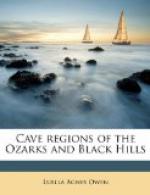“You see small holes eaten in the ceilings and walls in every direction, which indicates that the water came from a higher level, and being under great pressure, wanted passage out. It seems the cave was a reservoir for a long time, then after the water stopped flowing in it slowly receded, and in settling the overcharged waters covered the rocks and specimens with a calcareous coating, very thin in the upper portions of the cave and getting thicker the deeper you go, giving evidence as you see, of slowly settling. Had the waters rushed out they would in all probability have left the rocks uncoated as in all other caves, with one exception, the Crystal Cave, some seventy-five miles to the north of Wind Cave.
“As we have some more caves to see we must journey on.
“Taking one last look at Monte Cristo’s Diamonds we pass into Milliner’s Avenue, a very pretty avenue indeed with nearly as many colors as a milliner’s show-window would present. About mid-way of this avenue we cross the bridge over Castle Garden, a room in the eighth tier beneath the surface. From this avenue we step into the Assembly Room. Here the formations are covered with a gypsum crystal that sparkles with wonderful brilliancy. On the right is a passage leading to the Masonic Temple, a room that any body of Masons would be proud of could they hold lodge meetings in it. The passage on the left is the terminus of the Pearly Gates’ Route, the longest developed route in the cave. After moving along some distance we see the Bad Lands, and then come into the Tennis Court. This room has the net in the ceiling and I suppose the party can furnish the raquet (racket). On the right hand side of this room there is tier upon tier of box work; looking to the left, you shudder at the almost bottomless pit just beside the pathway. Here we take a rest preparatory to climbing up to the Marble Quarry, a task of two flights of stairs. This is a very large room and has the most uneven floor, ceiling and walls of any that our visitors see, and is barren of specimens excepting in the first part over the stairs where there is some box work of very pretty structure and color. Some distance up the path we see on one side the Ghost of ‘She,’ and on the other the Devil’s Punch Bowl, a large rock with a basin-shaped hole about thirty-six inches across and sixteen inches deep, but lo! the bottom has been broken out: which is very appropriate as South Dakota is at present a prohibition state. A winding path is followed until attention is called to the Sheep’s Head above an arch over the passage, and the ceiling here is of flint, the ledge of which is four inches thick.
“Passing under the arch we enter Johnstone’s Camp Ground, so named because Paul Alexander Johnstone camped in this room while accomplishing the third of his greatest mind-reading feats, during which he remained in the cave seventy-two hours. He was locked in his room at the Evans Hotel while a committee secreted the head of a gold pin in the cave. On their return, after being blindfolded, he led them to the livery stable, and securing a team drove to the cave and found the pin in the Standing Rock Chamber, beyond the Pearly Gates, and then drove back to the city still blindfolded.




